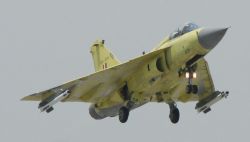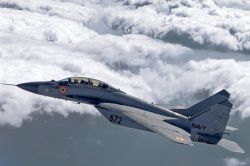Indigenous LCA, MiG-29K To Debut On INS Vikrant

India’s indigenous Light Combat Aircraft and the MiG 29K fighter planes will make their first appearance on the newly launched aircraft carrier, the INS Vikrant.
While the Indian Navy is eager to procure eight carrier version of the LCA; the first prototype aircraft has completed only four flight tests so far as part of a planned ski-jump from the shore-based test facility (SBTF) at INS Hansa in Goa this year.
The Prototype, known as NP-1, has not flown a sortie since last year after technical difficulties ensued. Since then, the Navy has enlisted its American help to complete crucial trials after an absence of experienced pilots forced the Aeronautical Development Agency (ADA), in charge of the project, to request the US Navy to train its test pilots.
The Navy plans to buy at least 42 aircraft in the lighter, more powerful Mark2 configuration, which is expected to be delivered in eight years.
The LCA will vary not only in appearance from its counterpart but it will also have a new stronger and longer landing gear, arrester hook for ship deck landing, front fuselage drooped for better over the nose vision to facilitate ship landing, an additional control surface to reduce ship landing speed and consequential changes in various systems.
According to reports, the LCA and MiG 29Ks will replace the aging depleting Sea Harrier squadron by 2014.
As for the MiG-29Ks, Russia will deliver the second squadron of aircraft meant for the indigenous aircraft carrier by 2015.
“The MiG-29K is heavier and faster than the Harrier and carries more weaponry. Its twin ‘marine-ised’ RD-33MK engines resist corrosion from the salty sea spray, and it goes up to twice the speed of sound (Mach-2). It operates at ranges that the Sea Harrier could not dream of, thanks to the MiG-29’s large fuel capacity and its capability to be refuelled mid-air,” according to a spokesperson.
Meanwhile, the INS Vikrant will be re-docked for erecting the island superstructure (for flight control systems) above its flight deck and the remaining underwater work. Major outfitting work is expected to be completed by 2016 followed by the extensive sea trials. The carrier is expected to be delivered to the Indian Navy by the end of 2018.
The aircraft carrier will be equipped with modern weapons systems including long range surface-to-air missiles (LR SAM) and close-in weapons system (CIWS).










